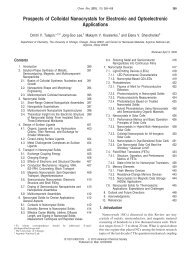∑ ∑
lec9.pdf
lec9.pdf
You also want an ePaper? Increase the reach of your titles
YUMPU automatically turns print PDFs into web optimized ePapers that Google loves.
the primal follows<br />
min <strong>∑</strong> u e l e<br />
e∈E<br />
s.t. <strong>∑</strong> l e ≥ 1, ∀p ∈ P(s,t)<br />
e:e∈p<br />
l e ≥ 0, ∀e ∈ E<br />
where l e can be interpreted as the length of the edge e in OPT D and u e l e therefore corresponds to the volume<br />
of the edge. So the objective of the dual is to find the volume-minimizing assignment of lengths to the edges<br />
so that that every s −t path has length at least 1.<br />
Theorem 1. Max-flow = Min-cut.<br />
Proof. First, we show that the dual above has 0−1 basic feasible solution. For an s−t cut ( S,S ) , let E ( S,S )<br />
denote the edges crossing the cut and let u ( S,S ) denote the sum of capacities of edges crossing the cut. For<br />
any s −t cut ( S,S ) , let l e = 1 for all e ∈ E ( S,S ) and l e = 0 for all others. Clearly, this is a feasible solution<br />
for the dual. It follows from weak duality theorem, max-flow ≤ OPT D ≤ integral min-cut.<br />
Next, we prove the other direction. Let l e be the length function and let d (v) be the shortest distance<br />
from s to v for all v ∈ V according to the lengths l e . Note that d (s) = 0 and d (t) ≥ 1. Consider ρ ∈ U.A.R [0,1)<br />
and let S ρ = {v ∈ V |d (v) ≤ ρ}, it follows<br />
E [ u ( )]<br />
S ρ ,S ρ = <strong>∑</strong> u e Pr ( e ∈ E ( ))<br />
S ρ ,S ρ<br />
e∈E<br />
Note that Pr ( e ∈ E ( S ρ ,S ρ<br />
))<br />
≤ le , we obtain<br />
E [ u ( )]<br />
S ρ ,S ρ ≤ <strong>∑</strong> u e l e<br />
e∈E<br />
This implies that there exists a ρ with u ( )<br />
S ρ ,S ρ ≤ <strong>∑</strong>e∈E u e l e , i.e. min-cut ≤ OPT D , which proves that maxflow<br />
= min-cut by strong duality theorem. Observe that for any u e ’s, there exists an integer s−t cut ( )<br />
S ξ ,S ξ<br />
with cost at most <strong>∑</strong> e∈E u e l e . This cut corresponds to<br />
{1 e ∈ E ( )<br />
S ξ ,S ξ<br />
y e =<br />
0 otherwise<br />
Clearly, y is also feasible for the dual. Now we have <strong>∑</strong> e∈E u e y e ≤ OPT D , it follows that <strong>∑</strong> e∈E u e y e = OPT D<br />
and l e = y e in OPT D . Thus, we have proved the integrality of l e ’s.<br />
3.2 Global Min-Cut<br />
Let us then consider the global min-cut problem. We show how to formulate a linear program and its dual<br />
for the global min-cut problem. The definition of the global min-cut problem is given as follows.<br />
Definition 2. (Global Min-Cut) Given in input an undirected graph G = (V,E) we want to find the subset<br />
A ⊆ V such that A ≠ /0, A ≠ V , and the number of edges with one endpoint in A and one endpoint in V − A<br />
is minimized.<br />
9-2
















